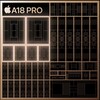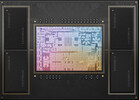Apple A18 Pro vs Apple M2 Pro vs Apple A6
Apple A18 Pro
► remove from comparison
The Apple A18 Pro is a powerful smartphone processor and formal successor to the A17 Pro. This new member of the Apple A processor series debuted in September 2024 alongside the iPhone 16 Pro and iPhone 16 Pro Max; it features 2 performance cores and 4 efficient cores along with a 35 TOPS NPU and the 6-core A18 Pro GPU.
The chip is said to be in large part based on the v9.2A ARM microarchitecture for near-Apple M4 IPC. 5G, Wi-Fi 7, Bluetooth 5.3, various satellite navigation systems and NFC are all supported here.
The more affordable A18 SoC has the same 2 P-cores and 4 E-cores running at slightly lower clock speeds along with a significantly slower graphics adapter. The Pro version of the chip also boasts USB 3.x support whereas devices powered by the A18 are limited to USB 2.0 speeds.
Performance
Its multi-thread benchmark scores leave the Dimensity 9300 as well as the Apple A17 Pro and the Apple A18 pretty far behind with at least a 10% advantage. Overall, Apple M1-like performance is to be expected in short-term workloads.
In the meantime, its single-thread performance comes dangerously close to the M3 and M4 chips despite their higher clocks speeds and slightly more advanced architectures. (The A18 Pro's performance cores can run at just slightly over 4.0 GHz, as far as we know.)
Performance drops are inevitable when under longer-term stress since there is no active cooling solution of any kind here.
Graphics
Like any modern graphics adapter, the 6-core A18 Pro GPU is RT-enabled. It delivers benchmark scores that are most comparable to the Immortalis-G720 MP12, Adreno 740 and Adreno 750; as a matter of fact, it even manages to beat the 7-core M1 GPU in many tests which is rather impressive. Any 2024 and 2025 iOS game will be happy with such an iGPU.
Power consumption
It appears the chip is able to briefly consume up to about 10 W when under high load, with average sustained power consumption figures hovering around 4 W.
The pretty modern TSMC N3E manufacturing process makes the A-series chip very power-efficient, as of late 2024.
Apple M2 Pro
► remove from comparison
The Apple M2 Pro is a System on a Chip (SoC) from Apple that is found in the early 2023 MacBook Pro 14 and 16-inch models. It offers all 12 cores available in the chip divided in eight performance cores (P-cores) and four power-efficiency cores (E-cores). The E-cores clock with up to 3.4 GHz, the P-Cores up to 3.7 GHz (mostly 3.3 GHz in multi-threaded workloads and 3.4 GHz in single threaded).
The big cores (codename Avalanche) offer 192 KB instruction cache, 128 KB data cache, and 36 MB shared L2 cache (up from 24 MB in the M1 Pro). The four efficiency cores (codename Blizzard) are a lot smaller and offer only 128 KB instruction cache, 64 KB data cache, and 4 MB shared cache. CPU and GPU can both use the 24 MB SLC (System Level Cache).
The unified memory (16 or 32 GB LPDDR5-6400) next to the chip is connected by a 256 Bit memory controller (200 GB/s bandwidth) and can be used by the GPU and CPU.
Apple states that the M2 Pro has a 25% higher performance than the M1 Pro in Xcode compiling.
The integrated graphics card in the M1 Pro offers all 19 cores.
Furthermore, the SoC integrates a fast 16 core neural engine (faster than M1 Pro), a secure enclave (e.g., for encryption), a unified memory architecture, Thunderbolt 4 controller, an ISP, and media de- and encoders (including ProRes).
The M2 Pro is manufactured in 5 nm at TSMC (second generation) and integrates 40 billion transistors.
Apple A6
► remove from comparisonThe Apple A6 is a dual-core SoC found in the iPhone 5 with ARM compatible CPU cores. The A6 was developed by Apple and supports the extended ARMv7s instruction set. The clock rate of the CPU is between 800 to 1200 MHz depending on the CPU load. The integrated GPU is a PowerVR SGX543MP3 at 266 MHz.
| Model | Apple A18 Pro | Apple M2 Pro | Apple A6 | ||||||||||||||||||||||||||||||||||||||||||||||||||||||||||||||||
| Series | Apple Apple A-Series | Apple M2 | Apple Apple A-Series | ||||||||||||||||||||||||||||||||||||||||||||||||||||||||||||||||
| Series: Apple A-Series |
|
|
| ||||||||||||||||||||||||||||||||||||||||||||||||||||||||||||||||
| Clock | <=4000 MHz | 2424 - 3504 MHz | 1000 MHz | ||||||||||||||||||||||||||||||||||||||||||||||||||||||||||||||||
| Cores / Threads | 6 / 6 2 x 4.0 GHz Apple A18 P-Core 4 x 2.2 GHz Apple A18 E-Core | 12 / 12 | 2 | ||||||||||||||||||||||||||||||||||||||||||||||||||||||||||||||||
| TDP Turbo PL2 | 10 Watt | ||||||||||||||||||||||||||||||||||||||||||||||||||||||||||||||||||
| Technology | 3 nm | 5 nm | 32 nm | ||||||||||||||||||||||||||||||||||||||||||||||||||||||||||||||||
| Features | 16-core Neural Engine, USB 3.2 Gen 2 (10 Gbps) | ARMv8 Instruction Set | |||||||||||||||||||||||||||||||||||||||||||||||||||||||||||||||||
| Architecture | ARM | ARM | ARM | ||||||||||||||||||||||||||||||||||||||||||||||||||||||||||||||||
| Announced | |||||||||||||||||||||||||||||||||||||||||||||||||||||||||||||||||||
| L1 Cache | 3.3 MB | ||||||||||||||||||||||||||||||||||||||||||||||||||||||||||||||||||
| L2 Cache | 36 MB | ||||||||||||||||||||||||||||||||||||||||||||||||||||||||||||||||||
| L3 Cache | 24 MB | ||||||||||||||||||||||||||||||||||||||||||||||||||||||||||||||||||
| Transistors | 40000 Million | ||||||||||||||||||||||||||||||||||||||||||||||||||||||||||||||||||
| iGPU | Apple M2 Pro 19-Core GPU |
Benchmarks
Average Benchmarks Apple A18 Pro → 100% n=1
Average Benchmarks Apple M2 Pro → 63% n=1
Average Benchmarks Apple A6 → 2% n=1
* Smaller numbers mean a higher performance
1 This benchmark is not used for the average calculation













